10 December, 2003
Ray’s Seismic Station
One objective for this year’s field season is to install a new seismic
station on the crater rim. Dr. Jackie Caplan-Auerbach, from the Alaska
Volcano Observatory, is heading up this project to assist Dr. Philip
Kyle, a volcanologist from New Mexico Tech who is the Principal
Investigator on this project. For the last four days, teams of 3-5
people have hauled over 300 pounds of gear up Ray’s Gully. We laid and
buried cable the first day, carried up a cement slab and housing for the
seismic station the second day, transported “Antarctic cement” and an
instrument box the third day, and assembled it all today.
This seismic station will ultimately be comprised of the seismometer
(which measures ground movement), a GPS unit, gas sampling devices,
infrared radiometer (measures heat flux), and an infrasonic microphone
(measures low frequency noise generated by the volcano).
The location for this seismic station was chosen for two reasons. First,
it is located on the rim of the crater in view of the lava lake, which
is useful in taking gas samples, infrasound readings and infrared
radiometric measurements. It is also on the east side of volcano in a
small saddle, therefore somewhat sheltered from wind, which creates
noise in the seismic signal.
Fortunately, the power station for this seismic site is located at the
bottom of the hill at Ray’s Gully. As the battery array is made of 18
batteries weighing 70 pounds apiece, we were relieved that we don’t need
to carry them up the 400 feet of vertical slope! All we had to do today
was assemble the housing and place the seismometer inside (Figures 1-7).
After the assembly was completed, Jackie and I headed back to the hut to
warm up. A glance at the weather station revealed an air temperature of
–22 C (– 7 F) with a wind chill of – 42 C (– 43 F). While the wind was
not as strong today, the temperature was about 10 degrees colder than it
had been for the last week. As I sit here typing my journals, I am
appreciative of the warm hut and keeping reminding myself that this is
the Antarctic summer!
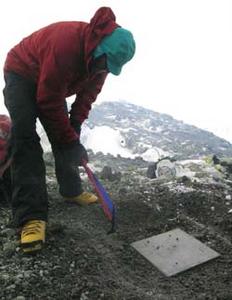
1. Figure 1 – Kurt smoothes the ground around the concrete seismic pad, which was installed yesterday at the top of Ray’s Gully. Permafrost makes it hard to dig into the ground, so the seismic station cannot be buried here.
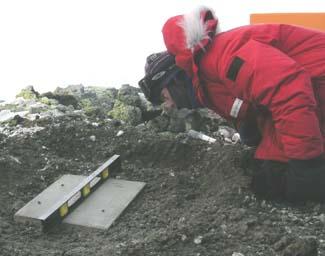
2. Figure 2 – Jackie checks that the pad is still level, a critical component in making the seismometer function properly.
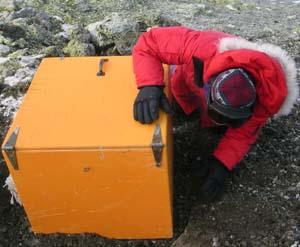
3. Figure 3 – A large orange box was placed around the concrete pad as a housing for the seismometer. Dirt was piled around the edges to help keep the box in place.
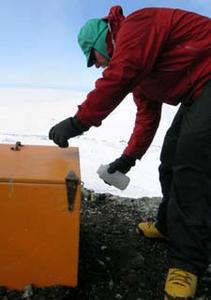
4. Figure 4 – To keep the housing and dirt in place, “Antarctic cement” is poured around the box. Note the water bottle in Kurt’s hand. Once frozen, water is as good as cement to hold the orange housing in place as the ice will not melt.
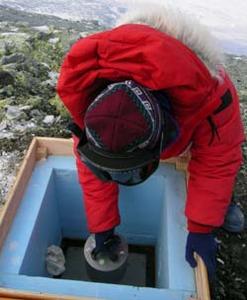
5. Figure 5 – Once the cement pad and housing are firmly cemented in place, Jackie sets the seismometer into position. Cables that were laid over the last few days will be connected to the seismometer for power.
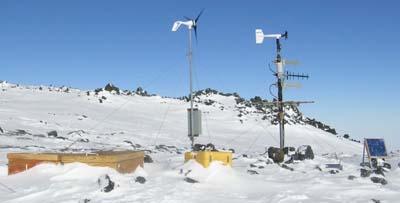
6. Figure 6 – The seismic signal will be sent to an antenna and radioed back to McMurdo station. This is a photo of a functioning seismic station called “Cones.” The wooden boxes at the left house a battery array that powers the station. The tower on the left is a wind generator that helps to recharge the batteries and serves as the only power source in the winter months. The second tower is the antenna that sends the seismic signal back to McMurdo. This station has a direct line of sight with McMurdo, but a station like “Rays” will have to bounce the signal off of a repeater tower. Visible on the right side of the photo is one of the solar panels that is used to recharge the batteries. Not visible at this sight is the orange housing for the seismometer. It is located out of the photo to the right.
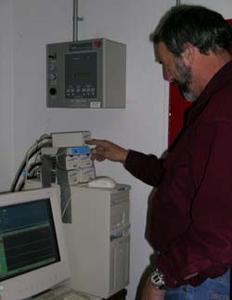
7. Figure 7 – Back at McMurdo station, a receiver detects the radio signal and sends it to a computer in the lab. The data is then sent on to New Mexico Tech for analysis.
Contact the TEA in the field at
.
If you cannot connect through your browser, copy the
TEA's e-mail address in the "To:" line of
your favorite e-mail package.
|
